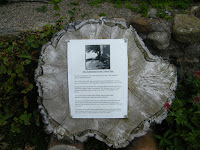It is fair to say that, at the moment, the outskirts of Lancaster do not look very pretty. The hillsides have fresh scars slashed across them as construction work continues on the M6-Heysham link road.
But, just a very short distance from there, I met a friend, who took me along one of her favourite walks.
 |
 |
 |
| It is believed that there might be a 'plague stone' on the lane - could this be it? |
I began by trying to decipher the name itself:
Shaw (sceaga) - copse, small wood
Grim/e - devil
So Grimeshaw = Devil's wood?
This seemed a bit simplistic, so I delved deeper.
Margaret Gelling, in her book Signposts to the Past, says: "It has been established that Grim meaning the masked one is a nickname for Woden, alluding to the god’s habit of going about in disguise; and the numerous earthworks called Grims Ditch, Grimsdyke, in many parts of the country are believed to contain this nickname, either because they were believed to be the work of the god, or as a vague expression of superstitious awe concerning their origin.
 |
The use of disguise by Woden is inferred from the many instances in which the corresponding Old Norse god Othin behaved in this way. We do not have narratives concerning the Old English gods of the sort which have survived for the ON deities, and there are many dangers in transferring ON information of a much later date to our own relatively brief pagan period. But a major characteristic like this one seems likely to belong to both traditions.
Not all English place names in Grims- are of this origin. Grimr was a common ON personal name and in the areas of England where Danes and Norwegians settled in the 9th and 10th centuries there are such names as Grimsby, Grimethorpe and Grimscoat, which contain this personal name and are of no special archaeological significance. Even in the Danelaw, however, a Grims- name referring to an earthwork is likely to allude to the god."
 |
| From the top of the ridge, the proximity to the M6 is visible |
A quick internet search told me (grimshaworigin.org) that "The Grimshaw surname originated in Lancashire in the northern part of England, apparently around 1000 A.D. There appear to be few records of Grimshaw family lines for the first 200 to 250 years. However, it is highly probable that the family’s roots are connected to the town of Grimsargh, which is a short distance northeast of Preston. The earliest recorded Grimshaw was Gilbert, father of William Grimshaw, who held the Manor of Grimsargh in thenage in 1242."
I looked for more information on the placename Grimsargh but could only find this, in Wikipedia: "The name Grimsargh is said to derive from an Old Norse name Grímr. One reference lists it as coming from the Domesday Book's Grimesarge, "at the temple of Grímr (a name for Odin.)" I had come full circle.
So what of the place itself? In Ancient Roads and Trackways in Quernmore/Lancaster Phil Hudson says: "There seems no doubt that in the pre-Conquest period there were some well used trackways which would have been part of the communications network for the many small, often defended circular ring-dyke farmsteads found in the area. Butler (l921)** makes reference to a "ridgeway" that passed through Quernmore on a north-south line, following the high scarp via Grimshaw Lane and across the River Lune ford to Halton.
 |
 |
From the top of the ridge, one can walk into Lancaster, and I was told the the witches of Pendle walked this way from the prison to their place of execution. From this high ridgeway, they would have known that they were walking in the direction of home, but never to return.
Although it is possible to 'name-check' these witches, overall this is a new facet to historical investigation for me. We do not know who else walked this route, where they lived, where they were going. I am used to having names as a starting point, even if they are only mentioned once or twice in primary sources. I research people, not places. To walk along that track, following the footsteps of countless unnamed people, was a new experience. This place is most definitely historical, but it is not going to give up its secrets any time soon.
*If you would like to know more about the campaign, visit their Facebook Page
**Butler, M.E. A Survey of the Geographical Factors that have Controlled the History of Lonsdale. Unpublished M.A. University or Liverpool 1921, 3O-4O.
[all photographs by and copyright of the author]






























